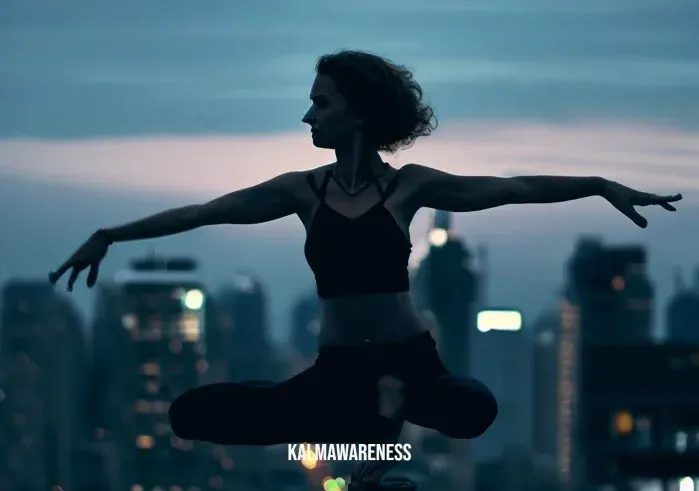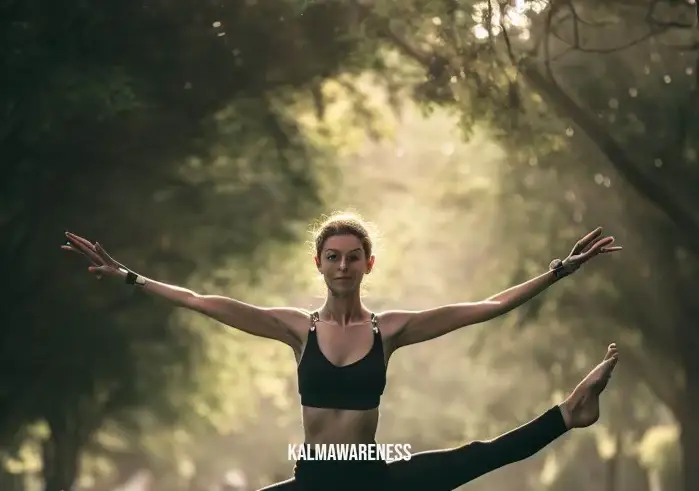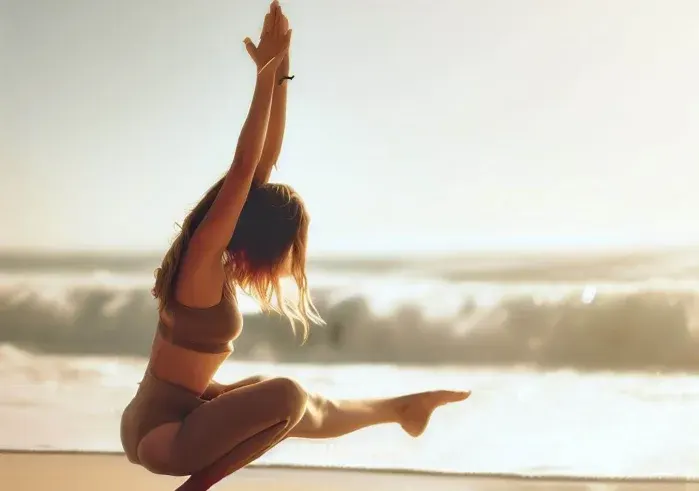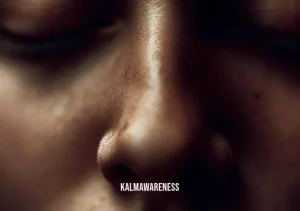Flying Crow Pose Yoga: Mastering Balance and Strength
In the world of yoga, there are numerous poses that challenge both the body and the mind. One such pose that embodies grace, balance, and strength is the Flying Crow Pose. If you’re looking to take your yoga practice to new heights and delve into the realm of arm balances, then the Flying Crow Pose is the perfect asana for you.
In this article, we will explore the ins and outs of the Flying Crow Pose, from its origin and difficulty level to its benefits and step-by-step instructions. So, fasten your seatbelt and get ready to soar through the exhilarating journey of this empowering yoga pose.
Pose Description and Explanation
| Description | Explanation |
|---|---|
| Pose Name | Flying Crow Pose Yoga |
| Original Name | Bakasana (Crow Pose) |
| Difficulty Level | Intermediate |
| Pose Category | Arm Balance |
| Exercise Duration | For beginners: Start with holding for 5-10 seconds |
| For advanced practitioners: Aim for 20-30 seconds or longer |
Benefits of Flying Crow Pose
Before we dive into the step-by-step instructions, let’s explore the remarkable benefits that the Flying Crow Pose offers:
- Strengthens the Arms and Core: The Flying Crow Pose engages the muscles of your arms, wrists, and core, helping to build strength and stability.
- Enhances Balance and Concentration: This challenging pose demands focus and concentration, improving your overall balance and mental clarity.
- Tones the Abdominal Muscles: As you engage your core to maintain the pose, the Flying Crow Pose provides an excellent workout for your abdominal muscles.
- Boosts Confidence and Inner Strength: As you master this advanced arm balance, you’ll cultivate a sense of accomplishment, confidence, and inner resilience.
Now that you’re aware of the incredible benefits that await you, let’s explore how to practice the Flying Crow Pose.
Step-by-Step Instructions
- Warm-up: Before attempting the Flying Crow Pose, warm up your body with a few rounds of Sun Salutations and some core-strengthening exercises.
- Start in a Forward Fold: Stand at the top of your mat, feet hip-width apart. Bend your knees slightly, and fold forward from your hips, bringing your hands to the mat.
- Plant Your Hands: Place your palms firmly on the mat, shoulder-width apart, slightly forward of your feet. Spread your fingers wide for added stability.
- Shift Your Weight: Transfer your weight onto your hands as you lean forward, bringing your knees to the back of your upper arms. Your knees should rest just above your elbows.
“Find your focus and embrace the sensation of balance. You are ready to take flight.”
- Engage Your Core: Activate your core muscles by drawing your navel toward your spine. This will provide stability and support as you lift your feet off the ground.
- Lift Your Toes: Slowly start to lift your toes off the mat, shifting your gaze slightly forward to maintain balance.
- Extend Your Legs: As you gain confidence, gradually extend your legs straight out behind you, parallel to the mat. Engage your thigh muscles and point your toes.
Remember to breathe deeply and find your point of focus as you hold the Flying Crow Pose.
“Feel the strength and grace within you as you soar in the Flying Crow Pose. Congratulations on completing the first part of this article! In the next section, we will explore variations and modifications to tailor this pose to different levels of practitioners. Get ready for more yoga inspiration!”
Stay tuned for Part 2 of this article, where we’ll delve deeper into the Flying Crow Pose, including variations and tips for practitioners of all levels. Keep exploring and enjoy your yoga journey!

Flying Crow Pose Yoga: Variations, Benefits, and Precautions
Welcome to the second part of our comprehensive guide to the Flying Crow Pose Yoga! In the previous chapter, we explored the foundational aspects of this empowering arm balance. Now, we will delve deeper into the world of Flying Crow Pose variations, the numerous benefits it offers, and the precautions to consider before attempting the pose. So, let’s spread our wings and soar into the fascinating realm of this invigorating yoga posture.
Variations for Different Levels
- Flying Crow Pose Variation 1 – Extended Leg Variation: Once you have mastered the basic Flying Crow Pose, challenge yourself by extending one leg straight back, parallel to the ground. This variation intensifies the core engagement and strengthens the legs even further.
- Flying Crow Pose Variation 2 – Tucked Knee Variation: If you’re looking for a modification that provides more stability, try the Tucked Knee Variation. Instead of extending your legs straight back, bend your knees and draw them towards your chest. This variation allows for a lower center of gravity and greater control.
- Flying Crow Pose Variation 3 – One-Legged Crow: Ready to take your arm balance practice to the next level? Explore the One-Legged Crow variation. Lift one leg off the ground, extending it straight back while maintaining balance on your hands. This variation requires increased core strength and stability.
- Flying Crow Pose Variation 4 – Crow to Handstand: For advanced practitioners, the Crow to Handstand variation adds an exhilarating element of inversion. From the Flying Crow Pose, gradually shift your weight onto your hands, lifting your legs off the ground, and extending them upward into a full handstand. This variation demands exceptional upper body strength, balance, and control.
Benefits of Flying Crow Pose
The Flying Crow Pose offers a wide range of benefits for both the body and mind. Let’s explore the remarkable advantages that this pose brings:
- Strengthens the Upper Body: The Flying Crow Pose targets the muscles of the arms, shoulders, and wrists, building strength and endurance in these areas.
- Enhances Core Stability: As you engage your abdominal muscles to maintain balance, the Flying Crow Pose strengthens and tones your core, leading to improved stability and posture.
- Improves Concentration and Focus: Balancing in an arm balance pose like the Flying Crow requires mental focus, promoting clarity of mind and enhancing concentration.
- Boosts Self-Confidence: As you progress in your Flying Crow practice and achieve stability and grace in this challenging pose, your self-confidence will naturally increase, both on and off the mat.
- Develops Overall Body Awareness: The Flying Crow Pose encourages a deep connection between the mind and body, enhancing body awareness and proprioception.
Precautions and Who Should Avoid the Pose
While the Flying Crow Pose offers numerous benefits, it may not be suitable for everyone. Here are some precautions to consider and individuals who should avoid this pose:
- Wrist or Shoulder Injuries: If you have a wrist or shoulder injury, it’s best to avoid or modify the Flying Crow Pose. Listen to your body and consult with a qualified yoga teacher or healthcare professional for appropriate modifications.
- Pregnancy: Pregnant individuals should avoid arm balances like the Flying Crow Pose, as they place additional pressure on the abdomen and may compromise balance.
- High Blood Pressure: If you have high blood pressure, approach arm balances with caution, as they can temporarily increase blood pressure. Always consult with your healthcare provider before attempting challenging poses.
- Beginners: Beginners or those new to arm balances should approach the Flying Crow Pose with patience and seek guidance from an experienced yoga teacher. Start with the foundational steps and gradually progress as your strength and confidence improve.
Remember, yoga is a personal journey, and it’s essential to listen to your body and practice with mindfulness and self-compassion.

Flying Crow Pose Yoga: Unveiling the Essence and Enhancing Your Practice
Welcome to the third and final part of our captivating journey into the world of Flying Crow Pose Yoga! In the previous chapters, we explored the foundational aspects of the pose, its variations, and the benefits it offers. Now, we invite you to delve into the rich history and spiritual significance of the Flying Crow Pose, along with valuable tips, modifications, and complementary poses. Let’s unlock the hidden gems within this empowering yoga posture and take your practice to new heights.
The History of Flying Crow Pose
The roots of the Flying Crow Pose trace back to the ancient practice of yoga. While specific details of its origin are elusive, the pose is often associated with the traditional Hatha Yoga system. Hatha Yoga, known for its focus on physical postures (asanas) and breath control (pranayama), provided a fertile ground for the exploration of arm balances like the Flying Crow Pose.
The Spiritual Significance of Flying Crow Pose
Beyond the physical benefits, the Flying Crow Pose carries profound spiritual symbolism. The act of balancing on the hands while extending the legs back represents the harmony between the earthly and celestial realms. It symbolizes the delicate equilibrium between effort and surrender, strength and grace, that we seek to cultivate in our lives. By practicing the Flying Crow Pose, we can deepen our spiritual connection, tap into our inner strength, and find balance amidst the chaos of the external world.
Tips for Getting the Most Out of Flying Crow Pose
To enhance your experience and maximize the benefits of the Flying Crow Pose, consider the following tips:
- Engage Your Core: Throughout the pose, actively engage your core muscles by drawing your navel towards your spine. This engagement creates stability and allows for smoother transitions.
- Find Your Drishti: Drishti refers to a focused gaze. Choose a point on the ground slightly ahead of you to fix your gaze during the pose. A steady drishti helps enhance your balance and concentration.
- Breathe Mindfully: Maintain a steady and controlled breath throughout the pose. Focus on deep inhales and slow exhales, allowing your breath to guide and support your movements.
- Practice Regularly: Consistency is key when it comes to advancing in any yoga pose. Dedicate regular time to practice the Flying Crow Pose, gradually increasing your hold time and exploring variations.
Common Mistakes to Avoid
As you refine your Flying Crow Pose, be mindful of these common mistakes and strive to avoid them:
- Collapsing Shoulders: Maintain openness in your shoulders and avoid rounding them forward. Instead, actively engage your shoulder blades and broaden your collarbones.
- Leaning Too Far Forward: Find the balance between leaning forward enough to lift your feet off the ground and leaning too far forward, which can compromise your stability. Focus on distributing your weight evenly on your hands.
- Neglecting the Foundation: Pay attention to the positioning and alignment of your hands. Spread your fingers wide, press through the knuckles and fingertips, creating a solid foundation for the pose.
Modifications for Injuries or Limited Flexibility
If you have injuries or limited flexibility, it’s essential to practice the Flying Crow Pose with modifications that suit your needs. Here are a few suggestions:
- Use Blocks: Place yoga blocks under your hands to raise the ground level. This modification reduces the distance between your hands and the floor, making the pose more accessible.
- Support with a Wall: Stand facing a wall and place your hands on the wall for support as you lift your feet off the ground. This modification provides stability and builds confidence.
- Knee-to-Arm Balance: Instead of extending your legs straight back, gently place one knee at a time on the corresponding upper arm. This modification allows you to focus on building strength and stability before progressing further.
Complementary Poses to Enhance Your Practice
To expand your repertoire of arm balances and strengthen the muscles necessary for the Flying Crow Pose, consider practicing these complementary poses:
- Crow Pose (Bakasana): Crow Pose is a precursor to the Flying Crow Pose and an excellent foundational arm balance that strengthens the arms, core, and wrists.
- Firefly Pose (Tittibhasana): Firefly Pose is an advanced arm balance that targets the core, arms, and inner thighs, preparing you for the challenges of the Flying Crow Pose.
- Side Crow Pose (Parsva Bakasana): Side Crow Pose builds on the foundation of Crow Pose and introduces twisting and lateral movement. It develops arm and core strength while enhancing balance and coordination.
- Eight-Angle Pose (Astavakrasana): Eight-Angle Pose challenges your arm and core strength while incorporating twisting and balancing elements. It serves as an excellent progression toward the Flying Crow Pose.
“Congratulations on completing our journey through the essence of the Flying Crow Pose! Remember, yoga is a lifelong practice that continually unfolds. Embrace the joy of exploration, cultivate patience, and honor the unique path that unfolds before you.”
By integrating these tips, modifications, and complementary poses into your practice, you will continue to expand your horizons, both physically and spiritually.
Conclusion
We hope this comprehensive guide has inspired and empowered you on your yoga journey. The Flying Crow Pose opens doors to strength, balance, and self-discovery. Embrace the challenges, savor the victories, and keep spreading your wings to new possibilities. May your practice continue to evolve and illuminate your path.
Keep shining, keep soaring, and keep exploring the depths of your potential!




